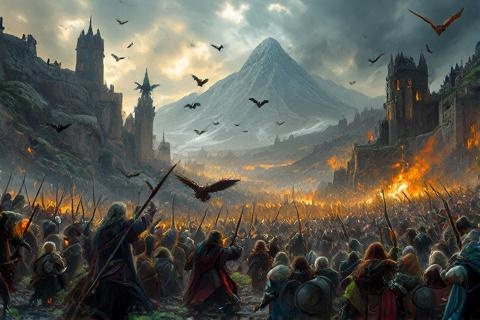
The Battle of Five Armies: The Turning Point in The Hobbit
How an Unexpected Battle Changed Middle-earth's Future
The Dragon's Demise and a Treasure Unguarded
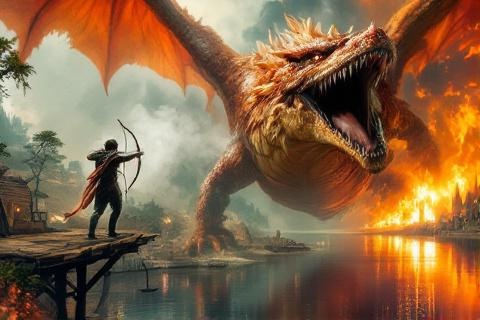
After the hobbit Bilbo Baggins and
his dwarf companions entered the Lonely Mountain, they awoke
the terrible dragon Smaug from his long slumber. Infuriated
by the theft of a single cup from his vast treasure hoard, the dragon's rage was
immense. Concluding that the Men of Lake-town must have aided the
intruders, Smaug burst from the mountain's gate and flew south towards the
settlement of Esgaroth, determined to unleash a fiery destruction upon its
people and their homes built upon the water.
Among the defenders of Lake-town was a grim man named Bard. He was a descendant
of Girion, the last lord of the ancient city of Dale, which Smaug had destroyed
centuries before. As the dragon began his assault, a small thrush, who had
overheard the dwarves discussing the dragon's weakness, flew to Bard. The bird
perched on his shoulder and told him about a bare patch in the thick, jeweled
scales on Smaug's left breast, a secret weakness known only to a few.
Armed with this crucial knowledge, Bard prepared his last and most precious
arrow, a Black Arrow that was a family heirloom passed down through generations.
As Smaug swooped low over the burning town for another attack, Bard took careful
aim with his great yew bow. He let the arrow fly, and it struck true, sinking
deep into the single unprotected spot on the dragon's underside. With a final,
agonizing shriek, the great dragon tumbled from the sky and crashed into the
waters, utterly destroying what was left of Lake-town in his fall.
The death of Smaug the Golden was a momentous event. For centuries, he had
terrorized the north and jealously guarded the immense dwarven treasure of
Erebor. Now, the dragon was dead, and the legendary hoard of the
King under the Mountain lay unguarded. This sudden power vacuum created a new
problem, as the news of a masterless treasure of unimaginable worth would soon
draw many powerful groups to the mountain's gate, each with their own claim and
desire for a share.
A Gathering of Armies
Word of the great dragon's demise traveled with astonishing speed through the
northern lands of Middle-earth. The news was carried by
birds and whispered on the wind, reaching the ears of kings, lords, and common
folk alike. The knowledge that the greatest treasure of the age was now free for
the taking sparked immediate action from all corners of the Wilderland, and
soon, armies were on the march toward the Lonely Mountain.
In his great halls in Mirkwood, the Elvenking
Thranduil heard the news and saw an opportunity. Long
ago, a portion of the treasure in the mountain had belonged to his people,
including a necklace of white gems that was exceptionally precious to him.
Believing the dwarves were all dead, Thranduil gathered a mighty host of Elven
warriors, armed with bows and spears, and marched west to lay
claim to what he considered rightfully his.
The human survivors of the destroyed Lake-town, now homeless and desperate, also
looked to the mountain for their salvation. They rallied behind their new hero,
Bard the Bowman, who had slain the dragon. They felt that the dwarves' quest was
the ultimate cause of their suffering, and they believed they were owed a
significant portion of the treasure as compensation for their losses and as aid
to rebuild their town and their lives.
However, Thorin Oakenshield, having finally reclaimed his ancestral kingdom, was
in no mood to share. The immense wealth of the hoard had a powerful and
corrupting effect on him, filling him with a fierce, irrational greed known as
the 'dragon-sickness'. When Bard and the Elvenking arrived with their armies and
made their claims, Thorin barricaded himself and his thirteen companions inside
the mountain, refusing to part with a single coin and declaring that he would
hold the treasure against any who tried to take it.
The Siege of the Lonely Mountain
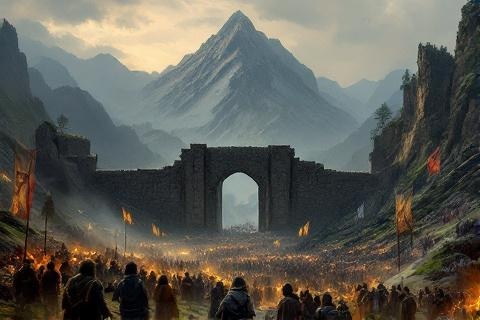
When the armies of Men and Elves arrived at the Lonely Mountain, they found the
Front Gate sealed with a wall of stone, hastily built by Thorin and his company.
Unable to enter and with their requests for a share of the treasure refused,
they had no choice but to surround the mountain. They established a camp in the
valley of Dale before the gate and began a siege, hoping to starve the dwarves
out and force them to negotiate.
Trapped inside his fortress but unyielding in his position, Thorin knew he could
not hold out forever against two armies. He remembered his strong and numerous
kin in the Iron Hills, a two-day march to the east. Using the ancient friendship
between the dwarves and the ravens of the mountain, Thorin sent messengers to
his cousin, Dáin Ironfoot, urgently requesting him to bring a well-armed force
of dwarves to break the siege and defend his kingdom.
Watching the growing tension and Thorin's descent into madness, Bilbo Baggins
was horrified at the thought of a war between people who should be friends. He
decided to take a huge risk to prevent bloodshed. During his exploration of the
treasure hoard, Bilbo had found the Arkenstone, a
magnificent white gem known as the Heart of the Mountain. Knowing it was the one
thing Thorin desired above all else, Bilbo secretly climbed down from the
mountain and gave the gem to Bard and Thranduil, hoping they could use it to
bargain with Thorin and bring a peaceful end to the standoff.
An Unexpected Enemy Arrives
The attempt at peace using the Arkenstone failed, as it only enraged Thorin
further. Just as the standoff was about to erupt into violence, the army of Dáin
Ironfoot arrived from the Iron Hills, a formidable force of over five hundred
dwarves clad in steel mail. They advanced into the valley, prepared to attack
the forces of the Elves and Men and break through to the mountain. A terrible
battle between the former allies seemed only moments away.
At that critical moment, a figure appeared suddenly between the opposing armies.
It was Gandalf the wizard, who had been absent but now
returned with a dire warning. He raised his staff and commanded them all to
stop, announcing that a far greater danger was approaching, an enemy that hated
them all equally. Gandalf revealed that a massive army of
Goblins from the mountains, riding upon monstrous Wargs, was
sweeping down from the north.
This goblin army was led by Bolg, the son of Azog the Defiler, a chieftain
Thorin had battled years before. The goblins of the north were filled with rage
over the death of the Great Goblin, who had been killed by Gandalf in the Misty
Mountains during the dwarves' journey. Hearing of the dragon's death and the
gathering of armies at the Lonely Mountain, they saw a perfect chance to seize
control of the entire region and take their revenge.
Faced with this terrible news, the leaders of the Dwarves, Elves, and Men had to
make a quick decision. The animosity over the treasure instantly seemed trivial
compared to the threat of total destruction. Bard, Thranduil, and even the proud
Dáin Ironfoot agreed to put their quarrel aside. In the face of a common foe,
they forged a quick and desperate alliance, turning to face the oncoming tide of
darkness together.
The Five Armies Clash

The leaders of the new alliance quickly formed a plan of battle. They chose the
valley of Dale, which lay nestled between two great spurs of the Lonely
Mountain, as their battlefield. This location offered a strong defensive
position where they could use the terrain to their advantage against the much
larger enemy army. Their strategy was to funnel the Goblins into the narrow
space between the high rocky arms of the mountain.
The term 'Battle of Five Armies' refers to the five distinct groups who fought
in this massive conflict. On one side stood the dark alliance of the Goblins and
the wild Wargs they rode. Against them stood the hastily formed league of the
Elves of Mirkwood, the Men of Lake-town, and the Dwarves of the Iron
Hills. It was a desperate fight for control of the north,
with the fate of many peoples hanging in the balance.
Following their battle plan, the allies took up their positions on the high
ground. The Elvenking Thranduil and his Elves were stationed on the southern
spur of the mountain, from where their archers could rain arrows down upon the
enemy. The Men under Bard and the Dwarves under Dáin took their stand on the
eastern spur. Their plan was to trap the Goblins in a deadly crossfire once they
entered the valley below.
The Goblins and Wargs charged into the valley with terrifying speed and
ferocity. Although the allies' initial volleys of arrows caused great damage,
the enemy's numbers were simply too vast to be stopped. The Goblin horde crashed
against the shields of the Men and Dwarves like a great wave, and the battle
soon became a desperate, close-quarters struggle. Slowly but surely, the sheer
weight of the enemy began to push the outnumbered defenders back.
Thorin's Charge and a Turning Tide
From within the Front Gate, Thorin Oakenshield and his twelve companions
listened to the dreadful sounds of the battle raging outside. The cries of Men,
Elves, and his own kin fighting for their lives finally broke through the grip
of the dragon-sickness that had clouded his mind. Ashamed of his greed and
realizing his duty as king, Thorin resolved to lead his company into the fray
and fight alongside the allies he had so recently scorned.
With a great effort, the dwarves inside the mountain tore down the stone wall
they had built to block the gate. Dressed in brilliant armor and carrying
gleaming weapons from the ancient hoard, Thorin and his companions suddenly
appeared. With a powerful cry of 'To me! To me! Elves and Men! To me! O my
kinsfolk!', Thorin led a thunderous charge directly from the mountain's gate and
into the thickest part of the Goblin army.
The unexpected sight of the legendary King under the Mountain and his
magnificent warriors charging into battle had an electrifying effect on the
weary allied armies. Hope was rekindled in their hearts, and they found new
strength. With a great shout, they rallied to Thorin's side, turning the tide
and launching a fierce counter-offensive that drove the surprised Goblins back
in disarray.
Thorin's charge was not a blind rush. He fought with purpose, cutting a path
through the enemy ranks with his axe, Orcrist. His goal was
to reach the leader of the Goblin host, the great chieftain Bolg, who was
surrounded by a personal guard of huge, fierce Goblins. Thorin knew that if he
could defeat their commander, the morale of the entire Goblin army might
shatter, leading to victory.
The Eagles Are Coming!
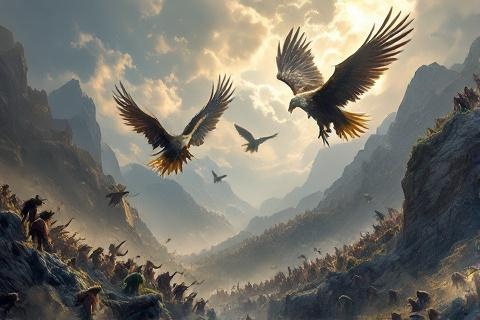
The battle grew ever more desperate. Thorin's charge had been heroic, but he and
his companions were now cut off and surrounded by Bolg's formidable bodyguard.
The main allied force was struggling to reach them, and it seemed that the
renewed hope would be short-lived. Just as the allies were being overwhelmed on
all sides and darkness was about to claim victory, a new and unexpected power
arrived.
Suddenly, high above the chaos, a great shadow fell over the battlefield. It was
a vast flight of the Great Eagles from their homes in the Misty Mountains. Their
lord, who was an ancient friend of Gandalf, had seen the Goblin armies gathering
and had led his followers to join the fight against their common enemy. Swooping
down from the sky with piercing cries, they were a magnificent and terrifying
sight.
The eagles' attack was decisive. They dove upon the Goblins who were climbing
the slopes of the mountain in an attempt to outflank the defenders from above.
The great birds tore at the Goblins with their claws and beaks, hurling them
from the cliffs and clearing the heights. This sudden assault from the air threw
the entire Goblin army into confusion and broke their attack, giving the
beleaguered allies a vital chance to regroup.
Bilbo Baggins, wearing his magic ring to remain invisible,
had been with the elves on the slopes when the eagles arrived. Overjoyed at the
sight, he cried out in triumph. Unfortunately, at that very moment, a large
stone cast by a desperate goblin fell from above and struck him on the head. He
was instantly knocked unconscious, and so he missed the final, most dramatic
turn of events in the great battle he had helped to start.
A Hero's Fall and a Final Victory
Just when it seemed there were no more surprises left, one final and mighty ally
made a dramatic entrance onto the battlefield. Beorn, the great man who could
change his shape into that of a bear, had heard of the Goblin army's advance and
traveled a great distance to join the fight. He appeared suddenly in the form of
a gigantic black bear, his eyes filled with a terrifying rage.
Beorn's arrival was devastating for the Goblin forces. He seemed to grow even
larger in his fury, and no weapon could stop him. He charged through the enemy
lines like a living storm, tossing Goblins and Wargs aside with his immense
strength. He broke through the ring of Bolg's bodyguard with unstoppable force,
carving a path of destruction directly towards the heart of the enemy command.
He reached the small clearing where Thorin Oakenshield lay on the ground,
pierced by many goblin spears. With great gentleness, the bear-man lifted the
wounded Dwarf-king and carried him out of the battle to safety. He then returned
to the fight, his anger now beyond all limits. He found Bolg, the Goblin
chieftain, and in a final, terrible display of power, he crushed him and his
remaining guards.
The death of their mighty leader at the hands of the fearsome bear was the final
blow for the Goblins. Their courage shattered completely, and the entire army
broke into a panicked rout. They fled in every direction, but there was nowhere
to hide. The victorious armies of Men, Elves, and Dwarves, along with the eagles
from the sky, pursued them relentlessly, ensuring that the great Goblin army of
the north was almost completely destroyed.
The Aftermath and a Sad Farewell
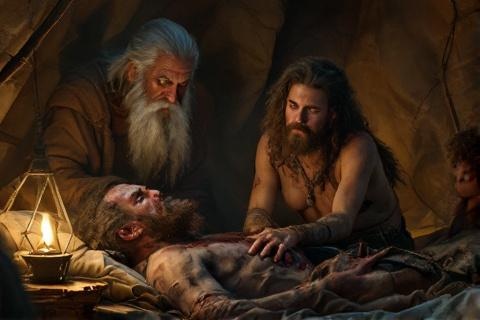
Although the allies had won a great victory, it came at a high price. Thorin
Oakenshield, the restored King under the Mountain, had been mortally wounded by
goblin spears. Before he passed away, he called for Bilbo Baggins. He apologized
for his greed and his harsh words at the gate, acknowledging the hobbit's
courage and good heart. They parted as friends, and Thorin's quest ended in both
triumph and tragedy.
Thorin was not the only one of his company to fall. His two brave nephews, Fíli
and Kíli, had also been slain in the battle. They had stood by their uncle's
side when he was surrounded by Bolg's bodyguard, defending him with their
shields and their own bodies until they were overwhelmed. Their loyalty and
sacrifice were honored by all who survived.
With the battle over and the enemy vanquished, the treasure of the Lonely
Mountain was finally distributed. Bard was given one-fourteenth of the hoard, as
Bilbo had offered on Thorin's behalf. He used this wealth to rebuild the city of
Dale and to help the people of Lake-town. The Elvenking received a gift of
beautiful emeralds, and peace was made between all the former rivals. Bilbo,
content with his adventure, refused a great reward and took only two small
chests of gold and silver home with him.
Following Thorin's death, his cousin Dáin Ironfoot was his rightful heir. He
became the new King under the Mountain, and the kingdom of Erebor was
reestablished. Under his wise rule, the mountain became a source of wealth and
beautiful craftwork once more. The dwarves lived in friendship with the Men of
Dale and the Elves of Mirkwood, and the entire region entered a new era of peace
and prosperity.
The Battle's True Importance
The Battle of Five Armies was fought over gold and old grievances, but it had a
much deeper significance that few understood at the time. Gandalf later
explained to Bilbo that his involvement in the quest had always been part of a
much larger plan. The wizard had long been concerned about the growing power of
the Necromancer in the fortress of Dol Guldur in southern
Mirkwood, who was later revealed to be the Dark Lord Sauron.
Gandalf knew that the Goblins of the north were becoming more organized and
powerful. He feared that Sauron might use them, along with the dragon Smaug, to
launch a massive attack on the northern lands while the kingdoms of the south
were distracted. This northern front could have overwhelmed key strongholds of
good, like Rivendell and Lórien, leaving the Free Peoples
vulnerable and divided.
The Quest of Erebor, which led to the death of Smaug,
created a situation that drew the entire northern Goblin army into a single
location. By uniting the Dwarves, Men, and Elves against this common threat, the
Battle of Five Armies became a huge, decisive engagement. The victory was so
complete that it shattered the power of the Goblins in the north for many
decades to come.
This outcome proved to be critically important years later during the War of the
Ring. Because the northern regions were secure and ruled by friends of the Free
Peoples, Sauron was unable to open a second front in the war. The kingdoms of
Erebor and Dale held off his Easterling allies, preventing them from sweeping
south. Without the victory at the Battle of Five Armies, the forces of Rohan and
Gondor might have been caught between two massive enemy armies,
and the quest to destroy the One Ring would have almost certainly failed.
